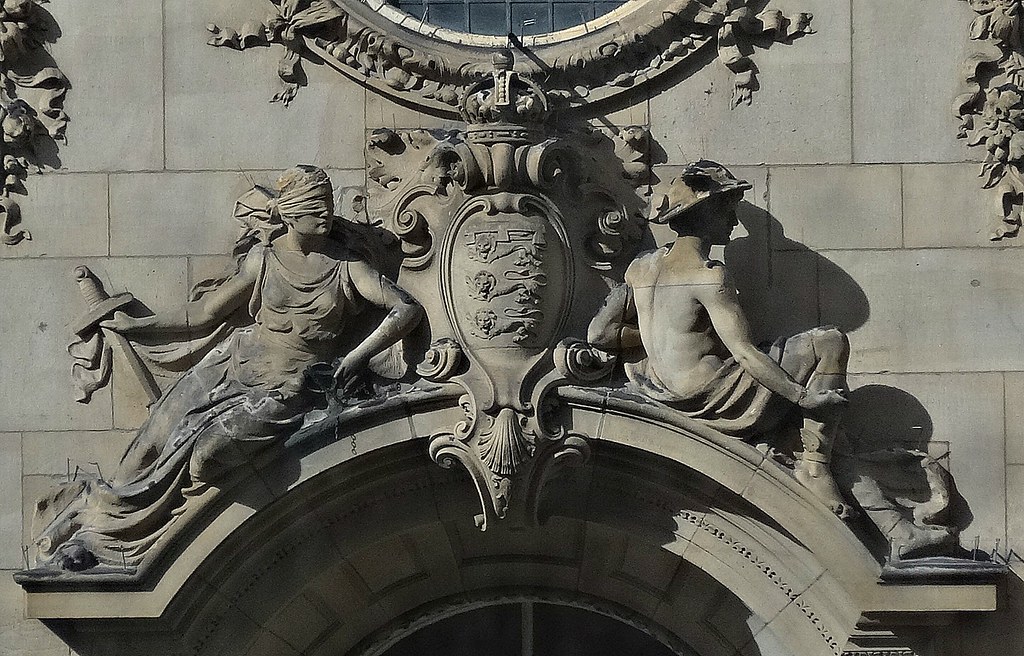habeas corpus ˌheɪbɪəs ˈkɔːpəs/ noun Law noun:
habeas corpus a writ requiring a person under arrest to be brought before a judge or into court, especially to secure the person's release unless lawful grounds are shown for their detention.
History of the sessions house
The Sessions House is a courthouse in Preston, Lancashire, England and is a Grade II* listed building. Built between 1900 and 1903 as a venue for the Quarter Sessions and Assizes it is still in use as a courthouse as well as being used as administrative offices for Her Majesty's Courts and Tribunals Service (HMCTS).
Designed by Manchester architect, Henry Littler (Littler was the architect who designed Whittingham County Asylum), in the Edwardian Baroque style and constructed of sandstone. The building has three floors topped with a tower. The tower makes Sessions House one of the tallest buildings in Preston rising to 54.7 metres . Situated on Lancaster Road, the main facade is on Harris Street facing the Harris Museum, the facade contains the most elaborate stonework. Carved over the window of the main entrance is the Roman goddess of Justice holding her scales. With her is Mercury the god who protects thieves. Higher up the base of the Tower are two more sculptures Hercules on the left and Britiania on the right. These sculptures were designed by Gilbert Searle who’s other work can be found at the Old Bailey in London.

Internally there are two courtrooms on the first floor that are used daily by Preston Crown Court together with a third smaller courtroom on the ground floor used by Preston County Court. The HMCTS Area Directors office for Lancashire and Cumbria is also situated in the building.
Geology Lesson:
The sessions house is made from Longridge sandstone which can be dated back to the Upper Carboniferous period ‘Silesian’ Millstone Grit Group Pendleton Formation Pendle Grit Member. Sandstones from this unit are probably the second most widely used building stone in Lancashire, surpassed only by the sandstones of the Haslingden Flags. Pendle Grit is typically an even-coloured, pale buff, medium to coarsegrained, feldspathic sandstone, with interbedded siltstone and mudstone. It is commonly developed as massive beds of up to 4.5m in thickness, with little, if any, visible internal structure (no cross-bedding, for example). There is little lithological variation across the outcrop area.
Pendle Grit sandstone is extensively developed in the Craven Basin, being found in the Lancaster, Settle, Garstang and Clitheroe areas. There were major quarries at Longridge and Lancaster – where it was known as ‘Longridge Stone’ and ‘Lancaster Freestone’ respectively. The sandstone was very widely used in all manner of civic, ecclesiastical, commercial, industrial, domestic and agricultural buildings over a wide area of Lancashire, especially in towns and villages close to the outcrop, and exported to the larger towns
Preston, in contrast, is primarily a town of brick buildings. ‘Longridge Stone’ is used in many of its prestigious buildings, however, including the Church of St. John the Devine and the Harris Museum. Most of the C19 stone buildings in the town centre and the Victorian Churches in the fringes and suburbs were constructed of the sandstone, while the better quality Victorian and Edwardian terraces and houses used ‘Longridge Stone’ decoratively. The stone was also utilised in similarly prestigious buildings in many other Lancashire towns, including Bolton Town Hall and in construction of the Liverpool Docks. It is also thought that the ‘Longridge Stone’ was extensively used in Lancashire’s railway architecture and structures.
The quarry at Waddington Fell (NW of Clitheroe) – lying within a Pendle Grit outcrop formerly mapped as ‘Warley Wise Grit’ – was reopened in about 1960 primarily for aggregate production. More recently, though, it has begun producing blockstone for sawing into building stone on site, and this is now widely distributed across Lancashire and beyond for both new-build and conservation purposes.
References
British Geological Survey
Harris Museum Preston
Wikipedia
To Log the EarthCache please message us through the messenger service. There is no need to enter the court house all your answers can be obtained from your observations walking around at street level. The court however is a public bulding and trails can be viewed from the public gallery should you wish.
- Why would Longridge Sandstone have been chosen to build the court house?
- Walk around the building and observe the Longridge stone.Tell me what is the colour of the Longridge Sandstone at GZ? Is the colour a consistant colour all the way around the building? Are there any other colours present? Can you describe any changes in colour?
- At GZ feel the sand stone - what does the grain feel like Fine, medium or coarse?
- Underneath the two wrought iron balconies on the Lancaster Road side of the court house you will see an identical sculpture under each balcony – what is unique about the eyes?
- Optional – a photo of you and your GPS at GZ